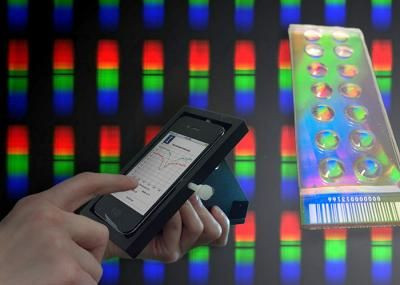Biosensor Smartphone App Is a Cheap Disease-Detecting Spectrometer [VIDEO]

A new biosensor system turns your smartphone into a powerful epidemiology tool, with an app that can detect toxic and disease-causing molecules on the fly as accurately as a laboratory spectrometer.
The system uses a portable cradle, developed by researchers at the University of Illinois at Urbana-Champaign, that contains optical components worth about $210 — far cheaper than stationary lab spectrometers that cost as much as $50,000.
The cradle, described in a paper published in April in the journal Lab on a Chip, takes ingenious advantage of smartphones' built-in processing power and high-resolution cameras.
"A lot of medical conditions might be monitored very inexpensively and non-invasively using mobile platforms like phones," said Professor Brian T. Cunningham, the leader of the development team, in a news release.
When hooked up to a smartphone app, the biosensor device can detect the presence of specific DNA strands, toxins, proteins, bacteria, viruses, and other molecules in samples in a matter of minutes.
That capability would let field doctors cheaply and reliably make medical diagnoses, all without having to send samples back to a lab or collect large amounts of blood.
It could even let researchers track the spread of diseases with smartphone GPS data, and conduct quick tests for food contamination in large samples.
Turning Your Smartphone into a Spectrometer
The biosensor system uses several separate parts: a smartphone app, a handheld cradle containing a series of optical lenses and filters, and a standard glass microscope slide coated with a photonic crystal biosensor material.
Photonic crystals are light-sensitive nanomaterials that reflect only specific wavelengths of light. When a biological sample is placed on the slide, target molecules in the sample, like proteins or DNA, are captured by the photonic material.
The biosensor slide is inserted into a slot in the cradle, which is aligned with the smartphone's camera. Optical components in the cradle detect the wavelength of target molecules in the sample, and the corresponding smartphone app translates the reading into a visualization of that wavelength along the visible color spectrum.
Re-measuring the sample's wavelength indicates the amount of the target molecule in the sample, allowing researchers to make conclusions about how much of a toxin is present, or how far a disease has spread.
In this Youtube video, Cunningham and graduate students Kenny Long and Hojeong Yu demonstrate how the biosensor smartphone app works:
Diagnosing Diseases and Tracking Pathogens with a Smartphone App
Cunningham's team successfully tested the biosensor smartphone app system by detecting concentrations of a pig antibody called immunoglobulin G.
The system used an iPhone, and the researchers say they are working on a cradle that can sync with Android smartphone apps. The cradle's manufacturing process needs to be streamlined, but they hope to make it commercially available next year.
The current system can only accommodate dry biological samples, but thicker biosensors in future versions might allow wet samples as well.
In the meantime, the researchers are developing specific protocols for biosensor tests that detect iron and vitamin A deficiency in children and pregnant women, they said in the press release. Other tests might detect toxins in harvest crops, or detect bacterial or viral contamination in food and water.
"It's our goal to expand the range of biological experiments that can be performed with a phone and its camera being used as a spectrometer," Cunningham said in the statement.
With enough distributed systems uploading massive amounts of data to the cloud, researchers can discover patterns to optimize health care in different geographic locations.
The biosensor system is the latest example of a smartphone app that gives users control over their own health care. Other apps offer mobile urine tests, detect food allergens, transmit heart scans, and even program artificial limbs.
Source:
Gallegos D, Long K D, Yu H, et al. Label-free biodetection using a smartphone. Lab Chip. 2013.



























